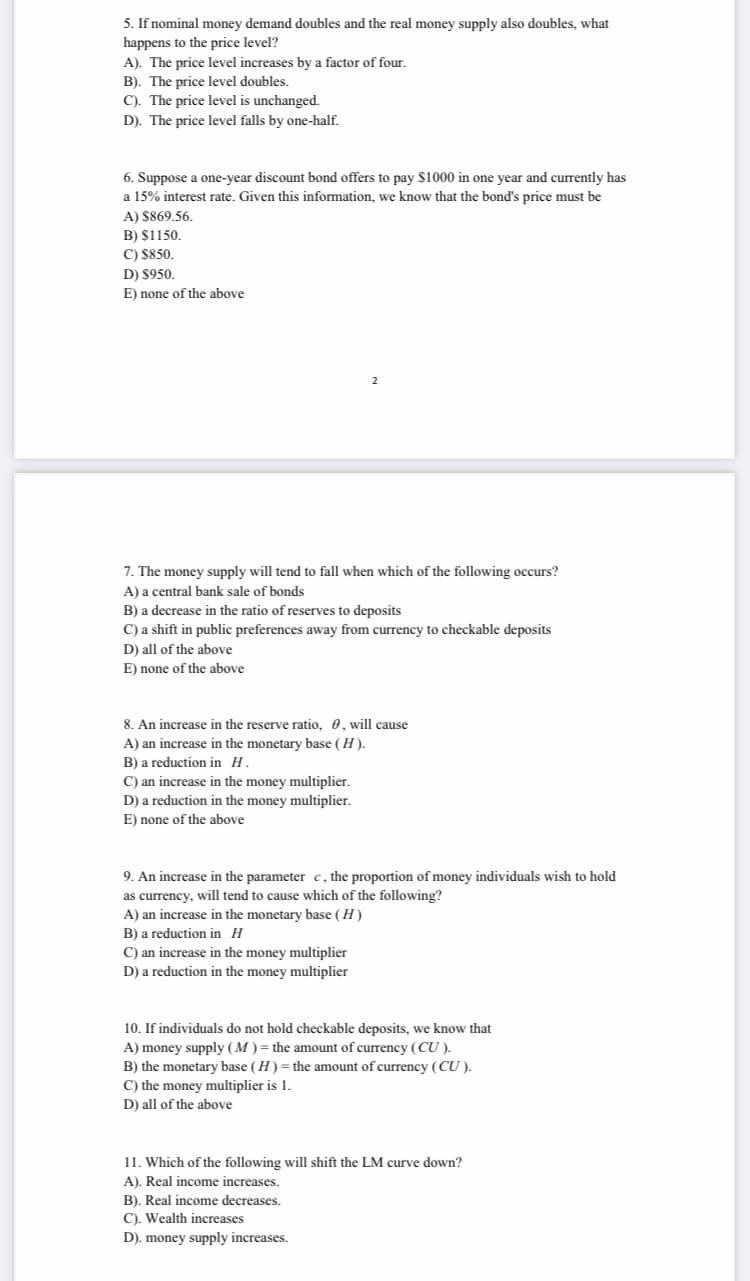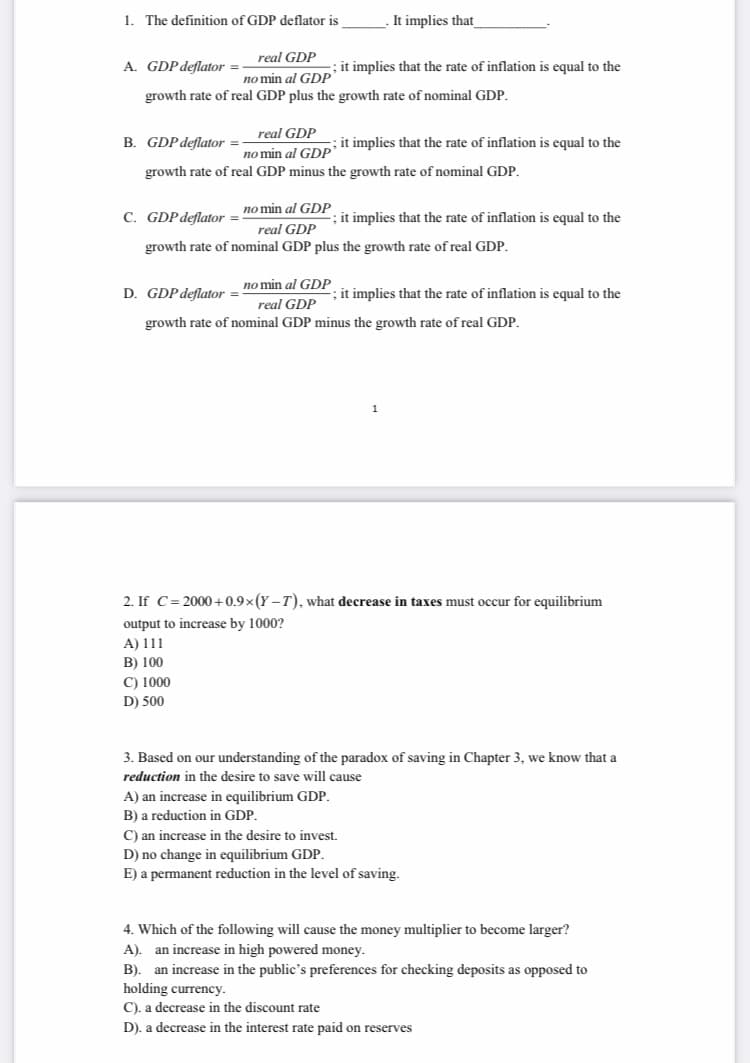1. The definition of GDP deflator is It implies that real GDP A. GDP deflator it implies that the rate of inflation is equal to the no min al GDP growth rate of real GDP plus the growth rate of nominal GDP. B. GDP deflator =- real GDP ;; it implies that the rate of inflation is equal to the no min al GDP growth rate of real GDP minus the growth rate of nominal GDP. C. GDPdeflator = no min al GDP real GDP -; it implies that the rate of inflation is equal to the growth rate of nominal GDP plus the growth rate of real GDP. no min al GDP ; it implies that the rate of inflation is equal to the D. GDP deflator real GDP growth rate of nominal GDP minus the growth rate of real GDP.
1. The definition of GDP deflator is It implies that real GDP A. GDP deflator it implies that the rate of inflation is equal to the no min al GDP growth rate of real GDP plus the growth rate of nominal GDP. B. GDP deflator =- real GDP ;; it implies that the rate of inflation is equal to the no min al GDP growth rate of real GDP minus the growth rate of nominal GDP. C. GDPdeflator = no min al GDP real GDP -; it implies that the rate of inflation is equal to the growth rate of nominal GDP plus the growth rate of real GDP. no min al GDP ; it implies that the rate of inflation is equal to the D. GDP deflator real GDP growth rate of nominal GDP minus the growth rate of real GDP.
Chapter18: Introduction To Macroeconomics: Unemployment, Inflation, And Economic Fluctuations
Section: Chapter Questions
Problem 13P
Related questions
Question
answers for this multiple questions.( without question 3)

Transcribed Image Text:5. If nominal money demand doubles and the real money supply also doubles, what
happens to the price level?
A). The price level increases by a factor of four.
B). The price level doubles,
C). The price level is unchanged.
D). The price level falls by one-half.
6. Suppose a one-year discount bond offers to pay $1000 in one year and currently has
a 15% interest rate. Given this information, we know that the bond's price must be
A) $869.56.
B) $1150.
C) $850.
D) S950.
E) none of the above
2
7. The money supply will tend to fall when which of the following occurs?
A) a central bank sale of bonds
B) a decrease in the ratio of reserves to deposits
C) a shift in public preferences away from currency to checkable deposits
D) all of the above
E) none of the above
8. An increase in the reserve ratio, 0, will cause
A) an increase in the monetary base (H).
B) a reduction in H.
C) an increase in the money multiplier.
D) a reduction in the money multiplier.
E) none of the above
9. An increase in the parameter c, the proportion of money individuals wish to hold
as currency, will tend to cause which of the following?
A) an increase in the monetary base (H)
B) a reduction in H
C) an increase in the money multiplier
D) a reduction in the money multiplier
10. If individuals do not hold checkable deposits, we know that
A) money supply (M) = the amount of currency (CU ).
B) the monetary base (H) = the amount of currency (CU ).
C) the money multiplier is 1.
D) all of the above
11. Which of the following will shift the LM curve down?
A). Real income increases.
B). Real income decreases.
C). Wealth increases
D). money supply increases.

Transcribed Image Text:1. The definition of GDP deflator is
It implies that
real GDP
A. GDP deflator =
it implies that the rate of inflation is equal to the
no min al GDP
growth rate of real GDP plus the growth rate of nominal GDP.
real GDP
B. GDP deflator =
it implies that the rate of inflation is equal to the
no min al GDP'
growth rate of real GDP minus the growth rate of nominal GDP.
no min al GDP
C. GDP deflator =
it implies that the rate of inflation is equal to the
real GDP
growth rate of nominal GDP plus the growth rate of real GDP.
no min al GDP
D. GDP deflator =
it implies that the rate of inflation is equal to the
real GDP
growth rate of nominal GDP minus the growth rate of real GDP.
2. If C=2000+0.9x(Y –T), what decrease in taxes must occur for equilibrium
output to increase by 1000?
A) 111
B) 100
C) 1000
D) 500
3. Based on our understanding of the paradox of saving in Chapter 3, we know that a
reduction in the desire to save will cause
A) an increase in equilibrium GDP.
B) a reduction in GDP.
C) an increase in the desire to invest.
D) no change in equilibrium GDP.
E) a permanent reduction in the level of saving.
4. Which of the following will cause the money multiplier to become larger?
A). an increase in high powered money.
B). an increase in the public's preferences for checking deposits as opposed to
holding currency.
C). a decrease in the discount rate
D). a decrease in the interest rate paid on reserves
Expert Solution
This question has been solved!
Explore an expertly crafted, step-by-step solution for a thorough understanding of key concepts.
Step by step
Solved in 2 steps

Knowledge Booster
Learn more about
Need a deep-dive on the concept behind this application? Look no further. Learn more about this topic, economics and related others by exploring similar questions and additional content below.Recommended textbooks for you

Exploring Economics
Economics
ISBN:
9781544336329
Author:
Robert L. Sexton
Publisher:
SAGE Publications, Inc

Brief Principles of Macroeconomics (MindTap Cours…
Economics
ISBN:
9781337091985
Author:
N. Gregory Mankiw
Publisher:
Cengage Learning

Essentials of Economics (MindTap Course List)
Economics
ISBN:
9781337091992
Author:
N. Gregory Mankiw
Publisher:
Cengage Learning

Exploring Economics
Economics
ISBN:
9781544336329
Author:
Robert L. Sexton
Publisher:
SAGE Publications, Inc

Brief Principles of Macroeconomics (MindTap Cours…
Economics
ISBN:
9781337091985
Author:
N. Gregory Mankiw
Publisher:
Cengage Learning

Essentials of Economics (MindTap Course List)
Economics
ISBN:
9781337091992
Author:
N. Gregory Mankiw
Publisher:
Cengage Learning

Principles of Economics (MindTap Course List)
Economics
ISBN:
9781305585126
Author:
N. Gregory Mankiw
Publisher:
Cengage Learning

Principles of Economics, 7th Edition (MindTap Cou…
Economics
ISBN:
9781285165875
Author:
N. Gregory Mankiw
Publisher:
Cengage Learning

Principles of Macroeconomics (MindTap Course List)
Economics
ISBN:
9781305971509
Author:
N. Gregory Mankiw
Publisher:
Cengage Learning